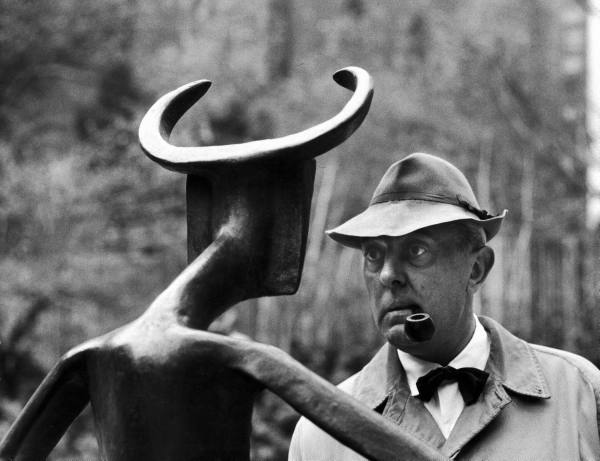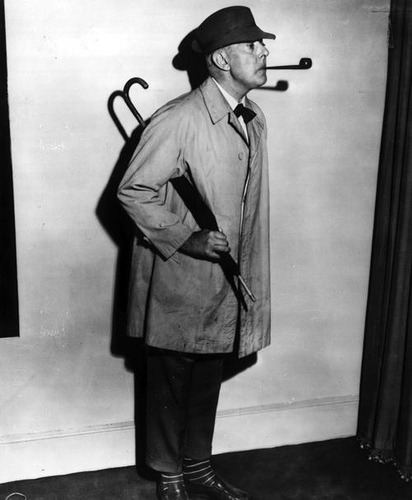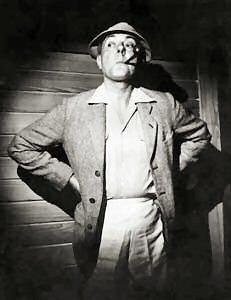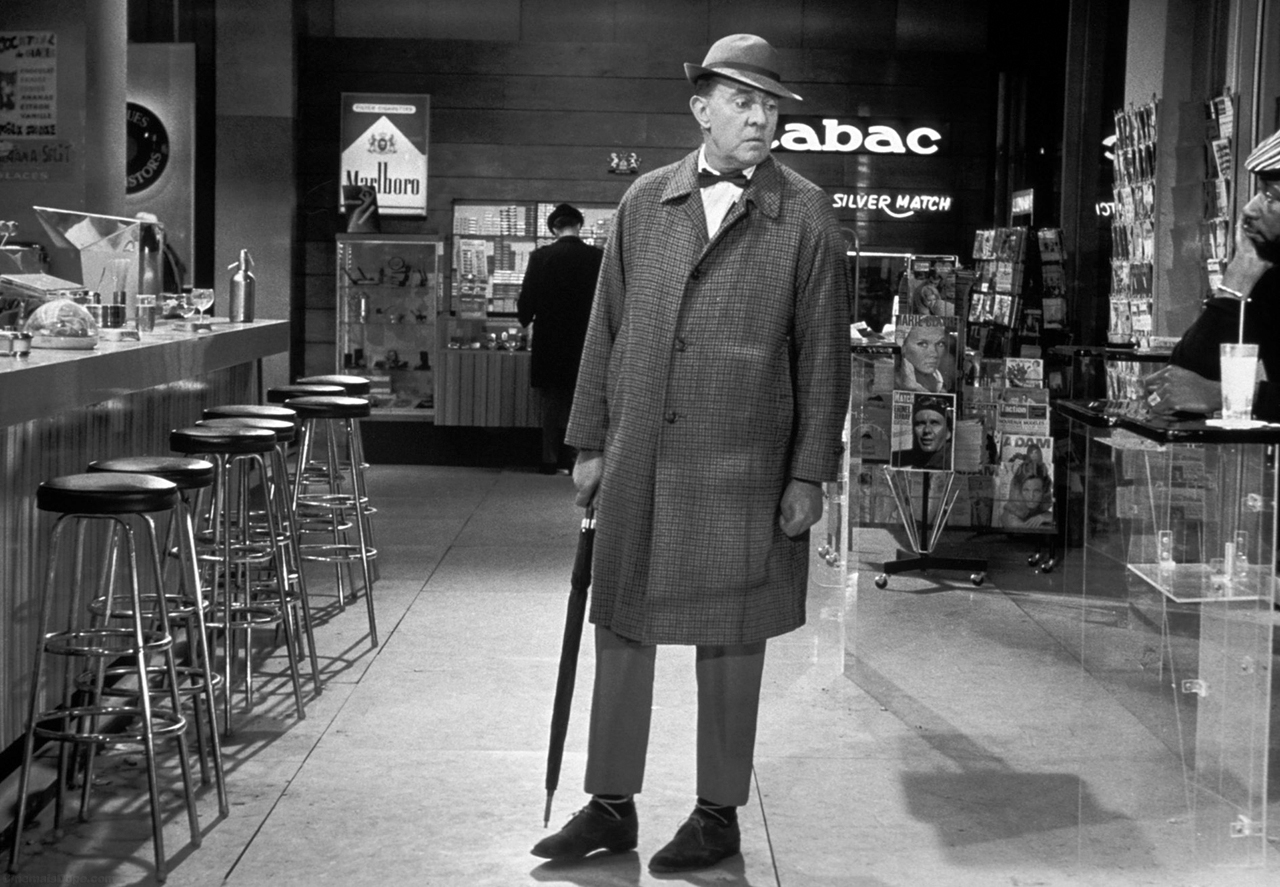<Back to Index>
- Physician, Physicist and Mathematician Johann Andreas Segner, 1704
- Director Jacques Tatti, 1907
- 1st President of Senegal Léopold Sédar Senghor, 1906
PAGE SPONSOR


Jacques Tati (born Jacques Tatischeff; 9 October 1907 – 5 November 1982) was a French filmmaker, working both as a comedic actor and director. In a poll conducted by Entertainment Weekly of the Greatest Movie Directors Tati was voted the 46th greatest of all time. With only six feature length films to his credit as director, he directed fewer films than any other director on this list of 50.
Tati was born in Le Pecq, Yvelines, the son of Russian father Georges - Emmanuel Tatischeff and Dutch mother Marcelle Claire van Hoof. The Tatischeffs (also spelled Tatishchev) were a Russian noble family of male line Rurikid descent; Tati's paternal grandfather, count Dimitriy Tatishchev (Дмитрий Татищев), was a Russian general and military attaché at the Russian embassy in Paris.
After a career as a professional rugby player, Tati found success as a mime in French music halls. In the late 1930s, Tati shot some of his early supporting cameos on film with some success but his career as a filmmaker would have to wait until after the Second World War.
In September 1939 at the outbreak of the Second World War Tati was conscripted into the 16th Regiment of Dragoons. Placed into a new unit, he fought in the Battle on the Meuse in May 1940. Tati ended up in Dordogne, where he was demobilized.
Between 1940 and 1942 he presented his Sporting Impressions at the original Lido de Paris. There he met the dancer Herta Schiel, who fled Austria with her sister Molly at the time of the Anschluss. In the summer of 1942, Herta gave birth to their daughter, Helga Marie - Jeanne Schiel. Following the pressure of his sister Nathalie Tatischeff, he refused to recognize the child and abandoned the mother and his first child.
Fleeing Paris under a cloud, Tati retreated to Sainte - Sévère - sur - Indre in 1943 with his friend, the writer Henri Marquet. Here they wrote the script of L'École des facteurs (The School for Postmen) that would later provide material for his first feature, Jour de fête. Jour de fête first demonstrated Tati's experimental approach to film making in his use of little audible dialogue, but instead is built around elaborate, tightly - choreographed visual gags and carefully integrated sound effects.
On 25 March 1944 Tati married Micheline Winter to whom he would father two other children, Sophie and Pierre Tatischeff.
Considered as possible substitute for Jean - Louis Barrault in Les Enfants du Paradis, he played the ghost in the ghost of Sylvia and Claude Autant - Lara and also appeared in The Devil in the same body. That's when he met Fred Orain, studio director of St. Maurice and those of the Victorine in Nice.
With the exception of his first and last films, Tati played the gauche and socially inept lead character, Monsieur Hulot. With his trademark raincoat, umbrella and pipe, Hulot is among the most memorable comic characters in cinema. Several themes recur in Tati's comedic work, most notably in Mon Oncle, Playtime and Trafic. They include Western society's obsession with material goods, particularly American style consumerism, the pressure cooker environment of modern society, the superficiality of relationships among France's various social classes, and the cold and often impractical nature of space age technology and design.
Tati's first major feature, Jour de fête (The Big Day), tells the story of an inept rural village postman who interrupts his duties to inspect the traveling fair that has come to town. Influenced by too much wine and a documentary on the rapidity of the American postal service, he goes to hilarious lengths to speed his mail deliveries aboard his bicycle. Tati filmed it in 1947 in the village of Sainte - Sévère - sur - Indre where he had found refuge from Nazi recruiters during the earlier German occupation. Released in 1949, the film was intended to be the first French feature film shot in colour; Tati simultaneously shot the film in black - and - white as an insurance policy. The newly developed Thomson colour system proved impractical, as it could not deliver colour prints; Jour de fête was therefore released only in black - and - white. Unlike his later films, it has many scenes with dialogue and offers a droll, affectionate view of life in rural France. The colour version was restored by his younger daughter, film editor and director Sophie Tatischeff, and released in 1995. The film won a prize at the Venice Film Festival.
His second film, Les Vacances de Monsieur Hulot (Mr. Hulot's Holiday), was released in 1953. Les Vacances introduced the character of Mr. Hulot and follows his adventures in France during the mandatory August vacation at a beach resort, lampooning several hidebound elements of French political and social classes. It was shot almost entirely in the tiny west coast seaside village of Saint - Marc - sur - Mer in the Loire Atlantique region. The hotel in which Mr Hulot stays (l'Hotel de la Plage) is still there and a statue memorializing the director has been erected along the beach. Tati had fallen in love with the coastline while staying in nearby Port Charlotte with his friends, M. and Mme Lemoine, before the war and resolved to return one day to make a film there. The film was widely praised by critics, and earned Tati an Academy Award nomination for Best Original Screenplay which was shared with Henri Marquet. It remains one of the best loved French films of that period. The film's comic influence has extended well beyond France and can be found as recently as 2007 in the Rowan Atkinson comic vehicle Mr Bean's Holiday.
Tati's next film, Mon Oncle (My Uncle 1958), was his first film to be released in colour. The plot centers on Mr. Hulot's comedic, quixotic and childlike struggle with postwar France's obsession with modernity and American style consumerism. Mon Oncle quickly became an international success, and won that year's Academy Award for Best Foreign Language Film, a Special Prize at Cannes, as well as the New York Film Critics Award. In Place de la Pelouse stands a bronze statue of Tati as Monsieur Hulot talking to a boy, in a pose echoing the movie’s poster.
Play Time (1967), shot in 70mm, was the most risky and expensive work of Tati's career, and it bankrupted him. It took nine years to make and he had to borrow heavily from his own resources to complete the picture. For Playtime, Tati fabricated a set (dubbed "Tativille") on the outskirts of Paris that emulated an entire modern city. In the film, Tati and a group of American tourists lose themselves in the futuristic glass - and - steel of the Parisian suburbs, where only human nature and a few views of the city of Paris itself still emerge to breathe life into the city. Playtime had even less of a plot than his earlier films, and Tati endeavored to make his characters, including Hulot, almost incidental to his portrayal of a modernist and robotic Paris. Playtime was originally 155 minutes in length, but Tati soon released an edited version of 126 minutes, and this is the version that became a general theatre release in 1967. Later versions appeared in 35mm format. In 1979, a copy of the film was revised again to 108 minutes, and this re-edited version was released on VHS video in 1984. Though Play Time was a critical success (François Truffaut praised it as "a film that comes from another planet, where they make films differently"), it was a massive and expensive commercial failure, eventually resulting in Tati's bankruptcy.
While on the set of Play Time, Tati made a short film about his comedic and cinematic technique, Cours du soir (Evening Classes, 1967), in which Tati gives a lesson in the art of comedy to a class of would-be actors. After Play Time, Tati made two more films, with more modest budgets. The first, Trafic (Traffic), was released in 1971. It was the last Hulot film, and followed the vein of earlier works that lampooned modern society. In the film, Hulot is a bumbling automobile inventor traveling to an exhibition in a gadget filled recreational vehicle. Despite its modest budget, Trafic was still very much a Tati film, carefully staged and choreographed in its scenes and effects. Tati's last completed film, Parade, a film produced for Swedish television, is more or less a filmed circus performance featuring Tati's mime acts and other performers. In 1978, Tati began filming a short documentary on a French (Corsican) soccer team playing the UEFA Cup final, 'Forza Bastia', which he did not complete. His younger daughter, Sophie Tatischeff later edited the remaining footage which was released in 2002 after her own death from lung cancer in 2001.
Tati had plans for at least one more film. Confusion, a planned collaboration with pop duo Sparks, was a story about a futuristic city (Paris) where activity is centred around television, communication, advertising, and modern society's infatuation with visual imagery. In the original script an ageing Mr. Hulot was slated to be accidentally killed on-air. While the script still exists, Confusion was never filmed.
The Illusionist (2010) is an animated film based on an unproduced, semi - autobiographical script that Tati wrote in 1956. Directed by Sylvain Chomet, known for The Triplets of Belleville, the main character is an animated caricature of Tati himself. Controversy has dogged The Illusionist. The Guardian reports,
In 2000, the screenplay was handed over to Chomet by Tati's daughter, Sophie, two years before her death. Now, however, the family of Tati's illegitimate and estranged eldest child, Helga Marie - Jeanne Schiel, who lives in the northeast of England, are calling for the French director to give her credit as the true inspiration for the film. The script of L'illusionniste, they say, was Tati's response to the shame of having abandoned his first child [Schiel] and it remains the only public recognition of her existence. They accuse Chomet of attempting to airbrush out their painful family legacy again.
Tati's former colleagues at the Lido de Paris were appalled at his caddish behaviour and shunned him. As a result he moved first to Berlin then to the village of Sainte - Sévère - sur - Indre, which later inspired his hugely successful film, Jour de Fête.
Chomet has a different opinion about the film's origins although acknowledging that he "never got to meet Sophie, or even speak to her about the script." Chomet said, "I think Tati wrote the script for Sophie Tatischeff. I think he felt guilty that he spent too long away from his daughter when he was working." Although Pathe Pictures appear to contradict Chomet's view with its own summary that,
"The film is based on an unproduced script that the French mime, director and actor Jacques Tati had written in 1956 as a personal letter to his estranged eldest daughter, Helga Marie - Jeanne Schiel in collaboration with long term writing partner Henri Marquet between Mon Oncle and Playtime. The main character is an animated version of Tati animated by Laurent Kircher. The plot revolves around a struggling illusionist who visits an isolated community and meets a young lady who is convinced that he is a real magician. The film is set in Scotland in the late 1950s. "...It's not a romance, it's more the relationship between a dad and a daughter...."

